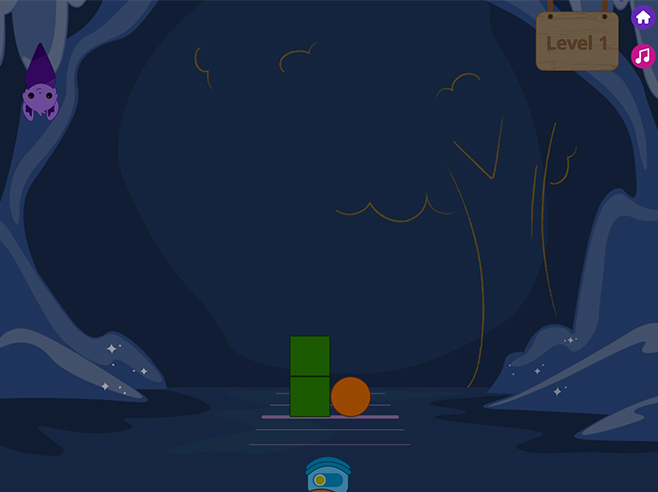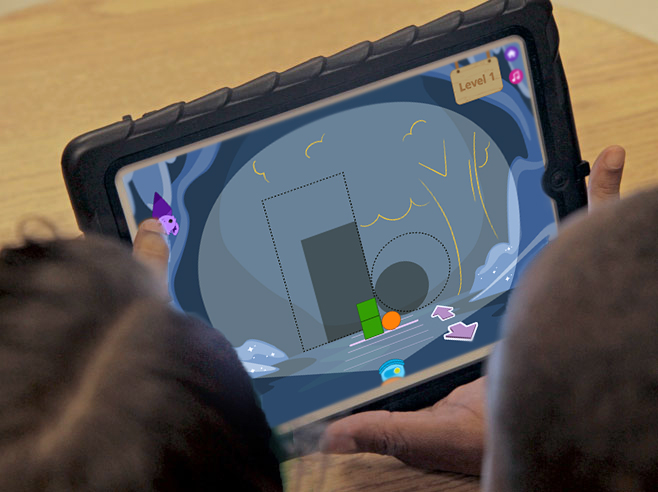Children explore shadows in a dark, digital cave. They make big and small shadows to match an outline that is on the cave wall.
Materials

- Shadow Cave app on iPads (1 device for Circle Time; 2–4 for Learning Centers)
- Projector (if available)
Preparation
- Familiarize yourself with the Shadow Cave levels you will introduce.
- If you prefer to use the app without music during parts of the game, tap the pink “music” button to mute all music.
- Note: As children work through the 12 levels in the Shadow Cave app, they are progressively challenged as the shapes available for building objects increase in number and type. How children position the shapes while building the objects also increases in complexity.
- Levels 1–2. Introduces the app and how to change the shadow size by moving the object closer to and farther from the light. Describe how a shadow is made.
- Levels 3–5, 7–8, 10–11. Children choose/name shapes from a backpack to build an object. The object is positioned between the light and cave wall and casts a shadow on the wall. Children move the object closer to/farther from the light to make the shadow on the wall bigger or smaller to fill the outline on the cave wall.
- Levels 6, 9, 12. Children choose/name shapes from a backpack to build their own object. They explore moving the object to make the shadow bigger and smaller. They can also explore adding a doodle to their shape creation.
Directions: Lesson 6
Circle Time: Introduction
This game is introduced in a whole-group activity. Use a projector or hold the iPad as you would a picture book for the group to see. Children will also explore the game independently at the Learning Center.
In each level you introduce, listen to the app audio and ask selected children to follow the prompts. Engage the group in a conversation, using science and math discussion prompts such as those below to continue exploring.
Invite children to listen as Nor introduces the Shadow Cave app. Spark their curiosity: Are you ready to explore the dark cave?
- Level 1. Have a volunteer tap the pulsing flashlight to turn it ON. What do you see on the cave wall? Point out that the object between the light and the wall is blocking some of the light and casting a shadow on the wall. Possible discussion ideas:
- What happened when we turned on the light?
- What do you think will happen if we turn off the light?
- Point out the pulsing arrow. Have another volunteer tap the arrow.
- What happened when you tapped the arrow? What do you notice about the shadow?
- Model tapping the pulsing arrow. Invite children to move the object closer to/farther from the light. Prompt them to closely observe what happens when the object is moved away from and closer to the light. Possible discussion ideas:
- What happened when we moved the object away from the light? Closer to the light?
- Ask children to guide you as you change the size of the shadow to fit the outline. How should I move the object to make the shadow the same size as the outline? Why do you think that? Continue until the object’s shadow fills the outline. Have them clap when the shadow is the same size as the outline.
- Then have a volunteer tap the blue “bat” button. Look! Ellie the bat makes a surprise when we make the shadow match the outline! What did Ellie make?
- Level 2. Follow the instructions provided for Level 1. Have one volunteer tap the arrows and another tap the blue bat button when the shadow fills the outline. Possible discussion ideas:
- What happened when you moved the object?
- Why do you think the shadow gets bigger or smaller when the object moves closer to or farther from the light?
- How can you make the shadow disappear?
- What surprise did Ellie the bat make?
- Levels 3-5. Point out the backpack and have children look closely at it. What do you think is inside the backpack? Have a volunteer tap on it.
- Notice how Nor is dragging a shape from the backpack to create an object. Have a volunteer drag the shapes onto the object’s outline.
- What shapes did you use to build the object?
- Did you use all the shapes in the backpack? How many shapes did you use?
- Tap the green play button. Look! The object is blocking the light. Does the shadow fit inside the outline on the wall? Is it too big or too small?
- Have a volunteer use the arrows to change the shadow’s size. What did you notice about the shadow? Why do you think the shadow got smaller/bigger?
- Ask children to guess what surprise Ellie will make. Then tap the blue bat button.
- Level 6. Ask children to describe what is on the screen. What happens if we turn off the light? Have a volunteer try it, then ask them to turn the light back ON and tap on the backpack. Point out there is no outline on the screen. Let’s use the shapes to build our own object!
- Count the shapes in the backpack together. Have two volunteers build an object using the shapes. Each child adds one to three shapes on the screen.
- What shapes did you use?
- Tap the arrow when the object is ready. Look at the shadow together. Point out how it matches the object built with the shapes.
- How many shapes did you use? How many shadows did you make on the wall?
- Have a volunteer tap the arrows to change the shadow size.
- How did you make the shadow bigger/smaller?
- Have children describe what the shadow shape looks like. Model how to draw a cave art doodle on the shape. Then tap the green play button to make the next shadow.
Learning Center
- Encourage children to listen to and build on each other’s ideas as they explore the Shadow Cave game in pairs or individually. Observe how children approach each level of the game, and use prompts such as those used during the whole-group exploration to engage children in science and math talk.
- Support children in thinking about cause and effect as they solve each level’s challenges, noting how shadows can be made to appear and disappear and change shape and size.
- Support children in identifying shadows made by various 2D shapes and recognizing how combining shapes can change the shape of a shadow. Possible discussion ideas:
- What shape(s) did you use to make that shadow?
- How does the shadow change when you add a (triangle) to the object?
- What do you notice about the shadow when you move the object closer to and farther from the light?
Circle Time: Wrap-Up
Children continue combining shapes to create an object that will cast a shadow on the cave wall. They also continue to explore how shadows change size when you move an object closer to and farther from the light.
- Level 6. Review children’s explorations from the Learning Center. Tap on the backpack. Have individuals or pairs demonstrate using shapes to build an object. Possible discussion ideas:
- How many shapes did you use? How many shadows appeared?
- What happens to the shadow if you add another (square) shape to the object? Describe the shadow now.
- Level 7. Have children describe their process as they build objects and create shadows on the wall. Prompt children to use different shapes to fit the outline. Possible discussion ideas:
- How many shapes are in the backpack? Can you name each shape?
- Is there another shape or shapes you can use to fill the outline?
- How many shapes did we use to build the object? How many shadows appeared?
- Level 8. Introduce children to a semicircle. Have children look at the outline on the cave wall. How many shapes make the outline? What shapes do you see? Tap on the backpack. Point out the circle and semicircles. Why do you think the two pink shapes are pulsing? Explain that each semicircle is half of a full circle.
- Have a volunteer drag the two semicircles to the outline. Did the two semicircle shapes fit the circle outline? What other object in the backpack would fit in that space? Have a volunteer try it. Then tap the green play button to see the shadow. Make the shadow fit the outline. Possible discussion ideas:
- How many shapes did we use to build the object?
- How many shadows appeared on the wall?
- What happened to the shadow when you moved the object closer to and farther from the light?
Directions: Lessons 7, 8, 11, 12
Learning Center
Children explore all 12 levels of the Shadow Cave app on their own or with a partner.
- Encourage children to listen to and build on each other’s ideas as they explore the Shadow Cave game in pairs or individually. Observe how children approach each level of the game, and use prompts such as those used during the whole-group exploration to engage children in science and math talk.
- Support children in thinking about cause and effect as they solve each level’s challenges, noting how shadows can be made to appear and disappear and change shape and size.
- Support children in identifying shadows made by various 2D shapes and recognizing how combining shapes can change the shape of a shadow. Possible discussion ideas:
- What shape(s) did you use to make that shadow?
- How does the shadow change when you combine it with a (triangle)?
- What happens to the shadow if you add another (square) shape to the object? Describe the shadow now.
- What do you notice about the shadow when you move the object closer to and farther from the light?


